
Dimitri
-
Content Count
21 -
Joined
-
Last visited
Posts posted by Dimitri
-
-
Hi Trev,sorry mate but looks like a melanistic normal grey to me, not bf. It could be also a melanistic bf, but in such a case it would be a poor example of bf since the belly should be black, not white. I think I see some little white feathers in the face (but I can't understand if it is white feathers or dust) if it be so, it's definitely not bf. Flanks completely devoid of spots is also sign of melanism. Such melanistic birds usually turn "normal" within a moult or two.ciaoDimitri -
Hi Trev,you have been clear enough, perhaps I have been not, let my try to explain better:your mating Cr split penguin x split penguin gives,in theory, 1 crested penguin out of 8 chicks. This is a rather low percentage, you could need no less then two full clutches to get only one "good" chick. Consider also that the ng chicks (both crested and not crested) produced from this mating could be split for penguin as well as they could not, so you could be in the need to use them in the following season to produce more crested penguins but you won't know which one is split and which one is not... what will you do?The mating proposed by Jeff Cr split penguin x penguin gives, again in theory, 1 crested penguin out of 4 chicks, that's to say you have good chance to hit the target already within the first clutch. And eventually, all the ng chicks produced (both crested and not crested) will be sure split for penguin, so if you need some split penguin to produce more crested penguins (or for example, one split parent could die) you can chose any of them and be sure of the results. I like to know perfectly what I have in my cages and breeding "possibly split" x "possibly split" is always a waste of room and time. That's why the best plan is first year Crested x penguin and second year Crested split penguin x penguin. When dealing with recessive mutation, split x split is the "last chance" mating, when only split birds are available, split x full is much better. Just my 2 cents.Of course, Dean could also pair a crested split penguin x split penguin and get 3 crested penguins chicks already in the first clutch... who can tell? That's the fun side of the hobby all the best to you toociaoDimitri
all the best to you toociaoDimitri -
Jugglerjeff: put a crested to a normal penguin.... then put one of the those crested chicks to another line of penguinsHi Dean,I think the most suitable mating has been indicated above by Jugglerjeff.Jeff's plan could give you a crested penguin in one or two rounds (1/4) and you will know the exact genetics of each offspring, while Trev's plan could give you a crested penguin after ages (1/8) and the genetics of all the ng chicks will be unknown until you "test" them with a penguin partner.ciaoDimitri -
Hi skm
as Trevor said, splits BB cocks can show oval shaped flank spots, then sometimes also the cheek patch can be slightly enlarged, in both sexes the tail blocks can be somewhat "irregular" and the tear marks can be thinner than normal.
As regards split BC, the tear mark can run a bit into the cheek area, you can see it on efinch too in the bc section.
But keep in mind that sometimes split are detectable and sometimes they are not.
ciao
Dimar
-
Here is a picture I took some years ago, these were not show type birds, which are more strongly marked like the one posted above by Sam, but the difference is quite visible.

ciao
Dimitri
-
Yes it's a pity, it was a nice hot spot.
I don't know if I can put a link here, but if you go to the Italian zf club homepage you can find several photogalleries with good pics of continental (Italian) birds.
ciao
Dimitri
-
Hi Paul
here is a young grey ccfw, just fledged
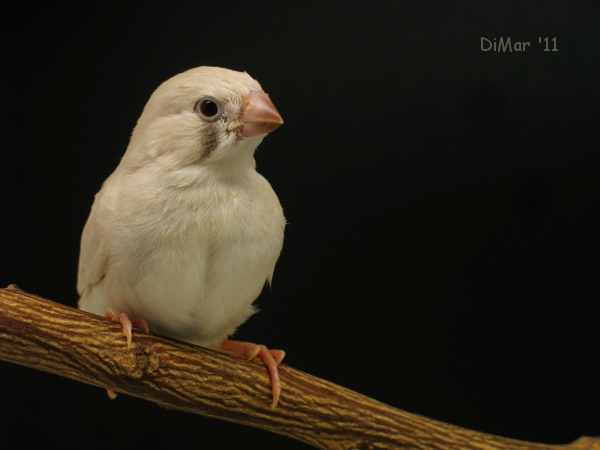
compared to a regular cfw fledgeling,
note the creamy overall colour, brown tear mark, horn coloured beak, the tail coverts are the same colour as the tear mark.
After moult the tear marks and tail coverts darken to black or almost black.
ciao
Dimitri
-
 1
1
-
-
Hi Kerry
CFW fawn chicks usually don't have horn coloured beaks, that description looks like a continental cfw hen. If it be so, the cock would be a CFW split CCFW and would be able to produce CFW and CCFW daughters. What about the tail coverts of the creamy chick? Are they washed out like in cfw, or evenly darker than usual?
cheers
Dimitri
-
Cheers for your valued input, i'm not so sure it is impossible to get black flanks in BF as although it is not now a factor of this mutation that doesn't mean that by some random chance this could not change, dont forget these random genetic occurances are where most of today mutations appear from in the first place, i believe most out comes are possible and the only limiting factor is infact the the colour factors found in the bird its self, for instance you would never be able to produce a yellow zebra finch because of the the lack of Lipochrome which is reponcible for this colour but zebra finches already have the Melanins need to produce a almost unlimited range of out comes with in this black, orange colour scale, a further example of this is the difference of the Australian mutations in comparison to our own.
Hi Paul,
I can't say you are wrong, random genetic events could give birth to a totally black, half black/half orange, or totally striped zf, immagination can run free here. However, if and when a black flanked BF would arise, it will be no more a BF, but rather a new mutation. Of course anything might happen in the future, who knows, but sadly we can't say for sure if, when, where and how it could happen. I guess (am I wrong?) Trevor was trying to understand which kind of birds should be best paired up in order to produce a black flanked BF, and not trying to understand if a black flanked BF could ever appear by chance in the next 50 years or so. That's why my answer is, for what we know today, "genetically" speaking, there's no mating scheme or selection trick to produce a black flanked BF.
some pics from past seasons, Paul perhaps you still remember some of these on the (dead) international forum
BFBC cock
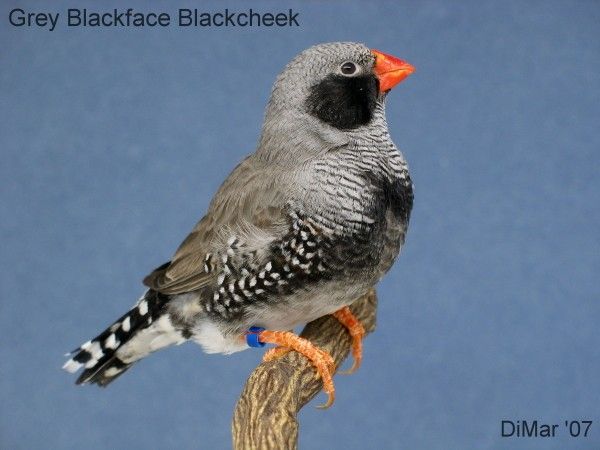
These BFs are all split BC, see the flanks...
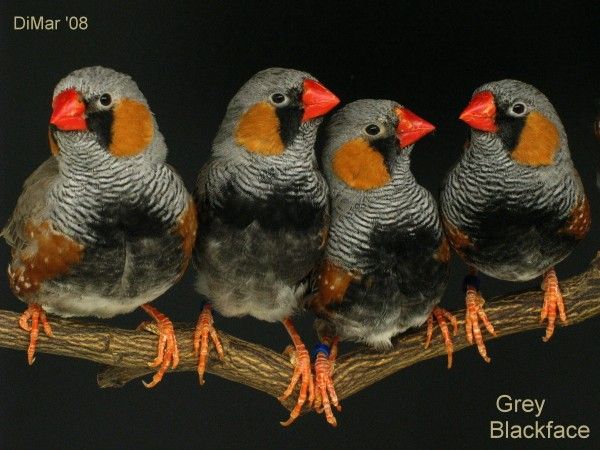
BF/BC hen
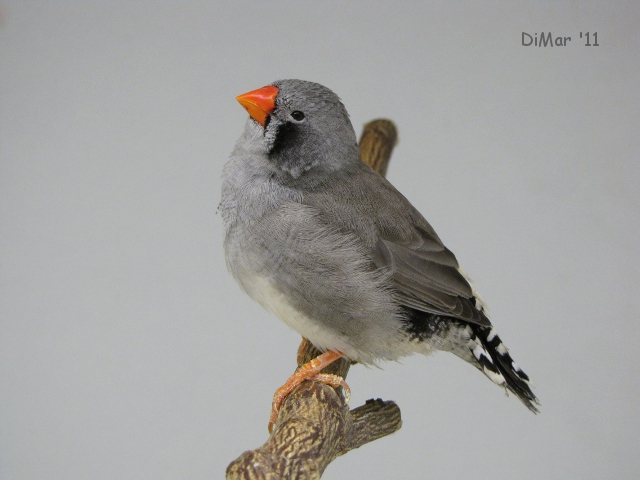
and the mossst blackessst BFBC on earth

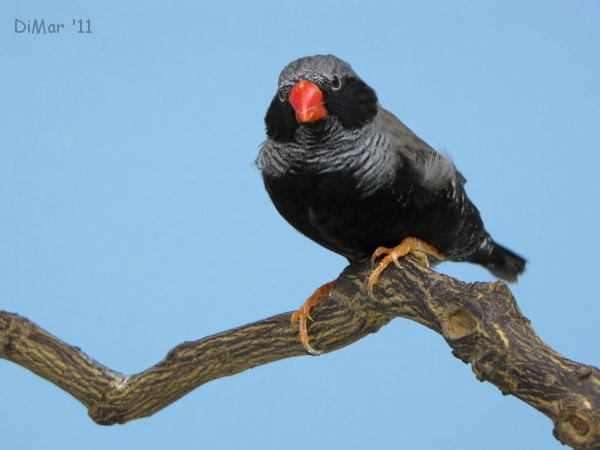
ciao
Dimitri
-
Hi Paul,
the reverse is not possible, because they are different mutations with different actions. BCs with chestnut flanks are just defective, pheomelanine is converted into eumelanine but in poor specimens it often works only partially, the action of the mutation must be supported and enhanced through selection. The chestnut flank of a blackface can't become black neither with the aid of selection, since BF gene doesn't do that conversion, pheomelanine markings remain untouched just like normals.
ciao
Dimitri
-
Wow 100% is great! never had hoped for such an excellent result

ciao
Dimitri
-
Hi Trev
I'm not sure I got it right, you want to breed a BF with black flanks? (without BC involved?)
BC turns pheomelanine markings (orange/chestnut) into eumelanine (black), and infacts BCs have black cheek patches and black flanks. BF instead has a different action, since it only adds black eumelanine in the lores and in the belly, but doesn't affect at all the pheomelanine in the markings. So you can get a black flanked zebra only if BC is involved (and the cheeks will be black as well).
ciao
Dimitri
-
the cock that breed the pictured bird was breed from a lightback cock - greycheek hen
the hen that breed the pictured bird was breed from lightback cock - greycheck hen
so we have the solution here:
the father is definitely grey split lightback (and split bb)
and the mother is not simply greycheek, but greycheek lightback indeed (and split bb as well)
therefore the pictured bird can only be lightback greycheek bb, as already said by Paul above.
ciao
Dimitri
-
Hi Jeff
you are right, basically an all white bird with red cheeks and flanks, hens are all white. They were "in fashion" twenty years ago here in Italy, but nowadays have been forgotten because of the difficulty to obtain a clear body with strong orange markings. There were three types of red flanked: penguin+cfw, cfw+isabel and penguin+isabel. The last one was said to be the best of the three, I have bred years ago only penguinxcfw, the body was clear white but the markings were washed out as well. No worth (to me).
ciao
Dimitri
-
That's great Paul, you are a lucky guy then, you can speak with him in person and you will quickly become like the Harry Potter of ZF genetics

ciao
Dimitri
-
Paul: ...the Lightback and CFW Chromosome Are According to the ZFS in the same location on the X Chromosome and passed together with Lightback Being Dominant to CFW,the first part is correct, LB and CFW are in the SAME location on the X chromosome, infact they are two different mutations of the SAME GENE. This means that the mutant gene can be LB or CFW, not LB and CFW at the same time.
Have you ever wondered WHY you can breed LB Fawn hens and CFW Fawn hens, but you can't breed LB CFW hens?? The hen have only one X chromosome, and since LB and CFW are mutations of the SAME gene, the X chromosome can only be LB - OR - CFW at a time, never LB CFW at the same time.
for example:
(cocks have two X chromosomes, hens have one X chromosome and one Y chromosome)
XLB, XLB = this is a lightback cock
XLB, Y = this is a lightback hen
XCFW, XCFW = CFW cock
XCFW, Y = CFW hen
XLB, XCFW = lightback/CFW cock (lightback split CFW cock)
now, as you already know, the LB/CFW cock transmits one X chromosome to each single offspring, i.e. XLB or XCFW,
and the hen transmits her XCFW chromosome (and a new cock will hatch) or the Y chromosome (and a new hen will hatch).
I remark that the LB/CFW cock can transmit the XLB chromosome OR the XCFW chromosome, it can't transmit both LB and CFW together at the same time on one X chromosome, just combine the cock chromosomes with the ones transmitted by the hen and you'll get the offsprings chromosomes (again, look at the punnett!)
I understand you still won't believe me, mostly after the Big Match of yesterday night
 :lol:
:lol:try to put your hands on a copy of the Blackwell's - Keeping and breeding Zebra Finches, the complete type standard guide -
it's the best english book ever published, with an excellent chapter about genetics and inheritance. The LB/CFW genetics is well explained there.

ciao
Dimitri
-
Hi Paul,
everything is OK, but the second last line is wrong! Ask Laus, who wrote the article, he knows zebra genetics and will admit that the secon last line is an oversight, you can bet on this mate and he will also thank you for the warning

Anyway, look again at the punnet I've posted before, zf genetics is not my opinion rather than your opinion, is mathematics.
ciao
Dimitri
-
Hi Paul,
for what I understand
 I think you're making a bit of mess
I think you're making a bit of mess 
a LB/CFW cock will pass the LB gene to half of the offsprings and the CFW gene to the other half, then if mated to a CFW hen will produce Lightbacks and CFWs 50/50 both males and females. Perhaps a punnet square is worth a thousand words...

ciao
Dimitri

Ob?
in All Other Colours
Posted · Report reply
Hi Kerry
looks like a fawn hybrid zebra x firetail, can you see a pinkish tinge in the tail bars?
ciao
Dimitri